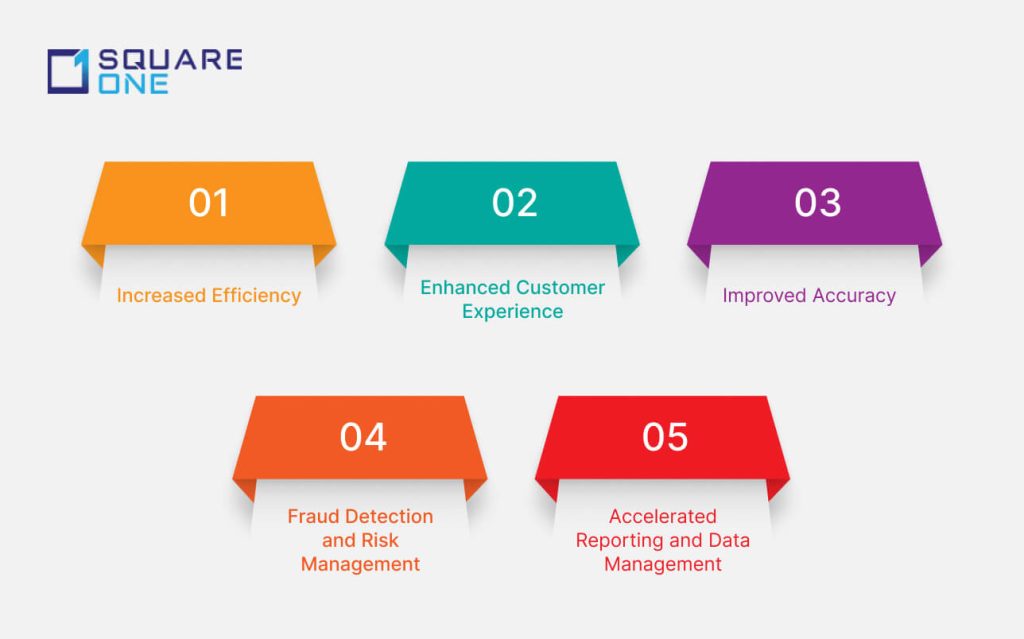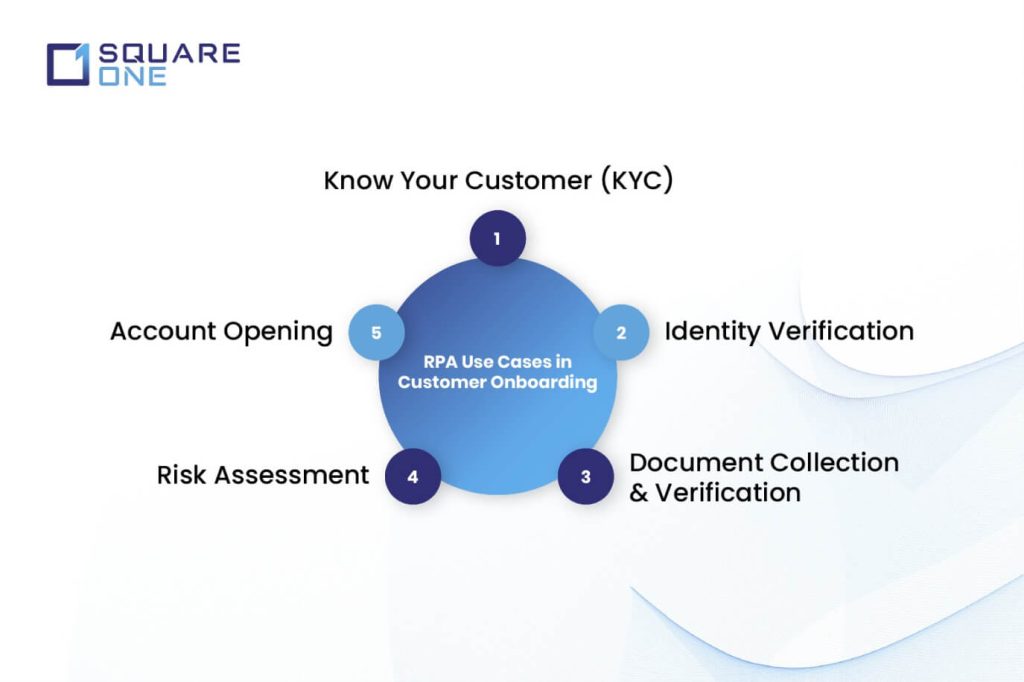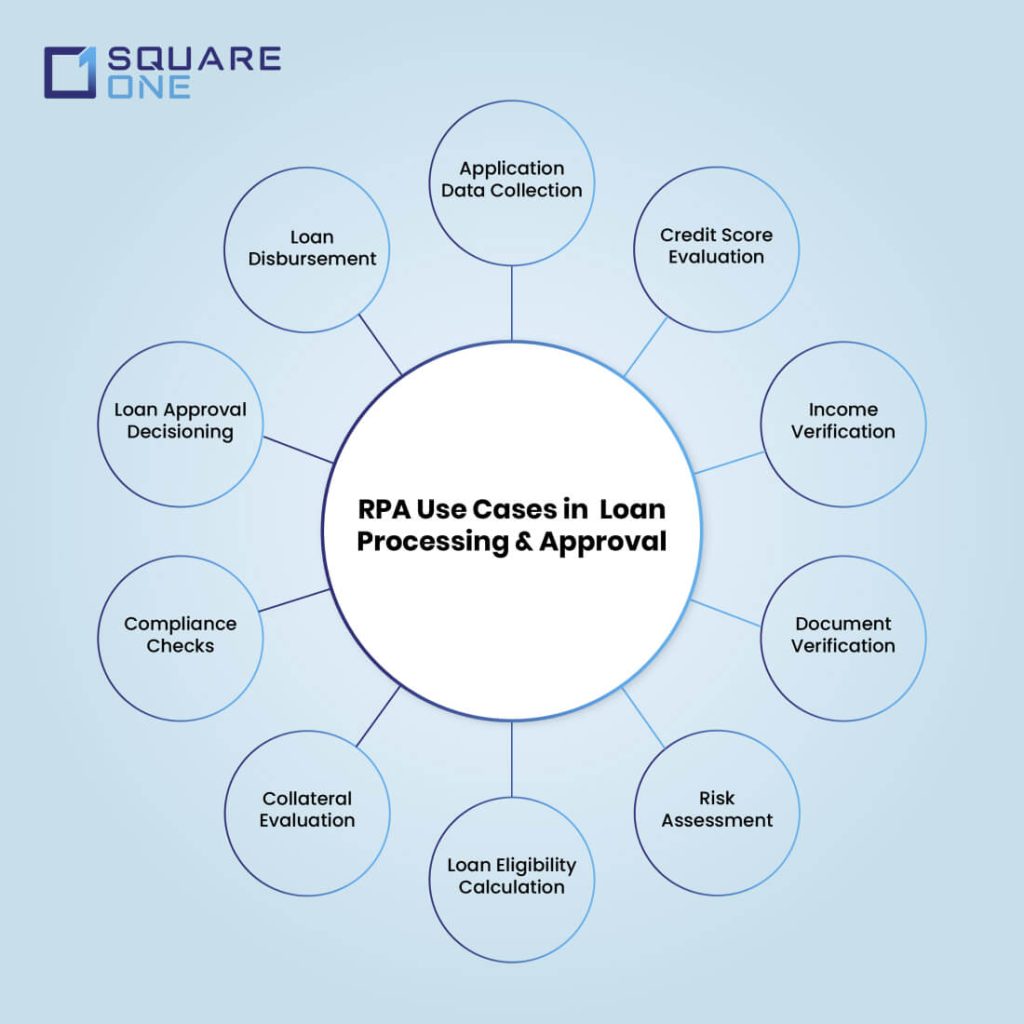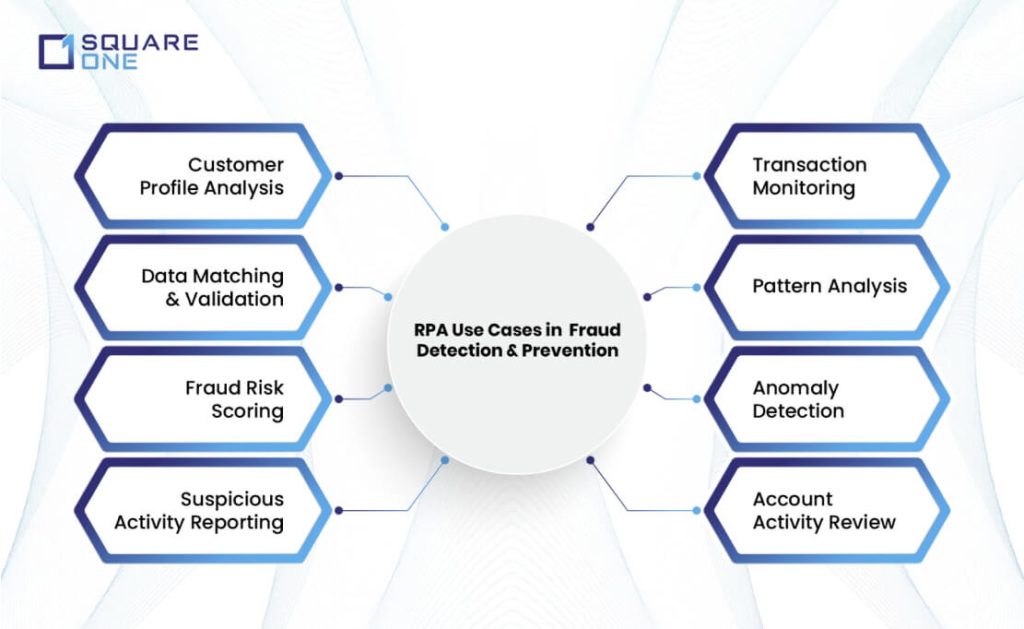RPA in Banking: A Comprehensive Guide to Automating Financial Processes
The landscape of financial services has expanded beyond basic banking operations, providing users with advanced and sophisticated solutions that ease their financial experience. Every service in the banking industry transforms how financial services function, from digital banking to wealth management—all thanks to the rapid adoption and advancements of Robotic Process Automation (RPA) solutions. Leveraging RPA has helped banks across the globe streamline and automate banking operations that are routine and repetitive, saving time and cost and reducing errors, allowing employees to focus on more intelligent and advanced processes that demand time and energy. Still trying to figure out what an RPA in banking is? The loan process you endure today is automated; all your verification and validation are done through software tools that automate most processes, eliminating manual interference and errors.

This blog delves into the role of RPA use cases in banking, highlighting its benefits and outlining implementation strategies for seamless adoption in the banking industry.
What is RPA?
As the name suggests, RPA is robotic automation software that utilises bots to perform humanised tasks with greater accuracy and consistency, delivering error-free outcomes in a limited time frame. In simple words, it is a helping hand for your daily routine tasks like scheduling appointments, organising emails, entering data, maintaining records, and other monotonous tasks that do not require human intervention and attention. RPA operates based on pre-defined rules and criteria and is ideal for tasks where the flow and processes are well-defined and established.
What is RPA in Banking?
The massive amount of data generated in the banking environment is high and complex to manage. Manual handling of data is laborious, time consuming and prone to errors, leading to inconsistencies and inefficient banking processes. RPA in banking operations is a need of the hour solution as it helps with the following processes
- Automates the process of data entry and migration, ensuring seamless and efficient transfer of large volumes of data.
- Compare and reconcile data from multiple sources efficiently, identifying discrepancies and errors.
- Validate and verify data against pre-defined rules and criteria, enabling data completeness and accuracy.
- Process data in real-time, providing up-to-date information for decision-making and reporting.
Embracing RPA helps harness the potential of data generated then and there; ensuring the derived insight is relevant. RPA integration in banking has become a necessity that banks cannot ignore or hesitate to integrate, for its potential is wide and vast and needs to be understood.
Discover the power of workflow automation solutions to enhance your organization’s efficiency. Explore our Workflow Automation solutions.

The Transformative Benefits of RPA in Banking
Let’s start with why RPA is for the banking sector. As one of the most regulated and risk-prone industries, it is essential to have technology solutions that assist in not just automating monotonous processes but also in identifying and flagging fraud and other irregularities, empowering employees with advanced solutions that are accurate and reliable. Also, the banking sector deals with many requirements, ranging from account opening to loan approval to account reconciliation to back-office operations. Catering to all this manually every day is highly draining and time-consuming. So, how does RPA support all of this? Here are the benefits of RPA in bank sector, providing detailed insights into why RPA is crucial for banking.

Increased Efficiency: Monotonic operations like entering data, monitoring transactions, or attending to customers can deter employees’ efficiency and performance in the long run, leading to low productivity. RPA’s adoption can be a feasible solution, as the bot can automate all such routine tasks without any human assistance, freeing up employees to focus on core objectives that are strategic and value-added activities. Also, the bot can work around the clock, ensuring business continuity and faster task completion with accuracy and efficiency.
Engaging Trivia: The projected value of the global Robotic Process Automation market is estimated to reach approximately USD 47.3 billion by the year 2033.
Enhanced Customer Experience: Providing timely customer responses is crucial yet demanding for banking professionals, who encounter many clients daily, each with diverse inquiries and requests. Responding to each is time-consuming and requires immense effort, which a bot like RPA can tackle quickly and conveniently. Built and configured to mimic human actions, the RPA bot does this exceptionally well when interacting with humans by providing consistent and accurate responses to all customer inquiries, ensuring uniform customer service.
Improved Accuracy: Processing every transaction with precision and accuracy is impossible, as humans tend to make calculation mistakes. However, with the help of RPA in banking, this can be solved, for the bot is designed and programmed with rule-based logic, data validation checks, error-handling mechanisms, and conditional logic codes that help handle complex transactions and perform accurate calculations, empowering high accuracy and reliability.
Fraud Detection and Risk Management: Flagging unusual patterns of transactions and identifying frauds in real-time is not feasible or possible in a manual process. However, RPA bots can monitor transactions for suspicious activities and flag potential cases in real-time, empowering risk mitigation for this susceptible sector. It can also periodically automate fraud detection assessments and compliance checks to identify possible threats and fraud activities.
Accelerated Reporting and Data Management: Handling extensive records of customer transactions, personal details, loan papers and other documents in a streamlined and consistent manner is time-consuming. Also, updating the newly added details across all the systems is a never-ending task for the employees. But with RPA, the bot may execute all operations in a standardized procedure that includes reducing variability and mistakes, verifying against multiple data sources, cleaning data duplication, updating data in real-time to all integrated systems, maintaining data consistency and facilitating better decision-making. Thus proving that RPA in the banking industry is a must-have solution.
3 Key RPA Use Cases in the Banking Industry

Customer Onboarding
- Know Your Customer (KYC)
- Identity Verification
- Document Collection and Verification
- Risk Assessment
- Account Opening
Let’s analyse the role of RPA in customer onboarding.
- The bot extracts customer data, such as contact information, personal details, and employment history, from all sources, including scanned documents, emails, and written formats.
- This is then automatically entered into the Customer Relationship Management (CRM) portal and other banking systems simultaneously, ensuring accurate and swift data entry.
- The bot further verifies the collected data against official databases and government portals. It also validates the customer address proof against available information, assuring the provided information is reliable and trustworthy.
- RPA can also perform AML checks by scanning customer data against sanction lists, global watchlists, and other illegal sites to confirm that the customer is risk-free.
- Once all the verifications are done, the RPA bot integrates with various banking systems to set up accounts, configure data features, and assign account numbers. It also automatically sends welcome notifications to users, providing them with login credentials and other necessary information.
- As a final step, bots can schedule and send follow-up communications to users, reminding them to complete any pending onboarding process if needed. RPA bots are even capable of handling initial customer support requests related to onboarding, either via email or chatbots
Thus, automating the onboarding process reduces the manual labour associated with it, lowering operational costs and improving customer satisfaction and experience.
Loan Processing and Approval
- Application Data Collection
- Credit Score Evaluation
- Income Verification
- Document Verification
- Risk Assessment
- Loan Eligibility Calculation
- Collateral Evaluation
- Compliance Checks
- Loan Approval Decisioning
- Loan Disbursement
Let’s analyse the role of RPA in loan approval and processing.

- The bot performs all preliminary checks, such as verifying income tax documents, salary slips, and other necessary records for loan processes.
- The RPA bot automates retrieving credit reports from credit bureaus to check the customer’s creditworthiness.
- The bot further helps assess other risk factors like debt-to-income ratio, credit score, employment stability, and repayment history, helping the employees better understand customer potential.
- Based on its predefined rules, the bot can automatically accept or reject a loan application or flag it for further review by a human underwriter.
- Following this, the bot notifies the customer regarding their loan application status and facilitates the collection of digital signatures from applicants, streamlining the approval process.
- As a final step, the RPA bot also helps with disbursing funds, scheduling reminders of due payments, and updating loan account details with current terms and conditions.
This shows how RPA’s assistance in the loan verification and approval process is both successful and efficient.
Engaging Trivia: The finance sector has an adoption rate of approximately 8% for RPA
Fraud Detection and Prevention
- Transaction Monitoring
- Pattern Analysis
- Anomaly Detection
- Account Activity Review
- Customer Profile Analysis
- Data Matching and Validation
- Fraud Risk Scoring
- Suspicious Activity Reporting
Let’s analyse the role of RPA in fraud detection and prevention.

- RPA’s ability to handle large volumes of transactions helps with its continuous monitoring capabilities, which track and identify potential risks in real time, even during peak transaction hours.
- The bots have the capability to perform behavioural analysis, tracking and analysing user transaction patterns and behaviours against a benchmarked baseline of normal activity. Any deviations from this are flagged as unusual or fraudulent activity. Also, its machine learning integration helps in the accurate detection of anomalies and prediction of potential frauds based on analysing historical data.
- Based on its predefined criteria, the bot can assign risk scores to customer accounts depending on the frequency of transactions, amount handled, location and other important information. This helps employees prioritise profiles with high risk scores.
- When the bot spots any suspicious activity, it instantly generates alerts or notifies users and the fraud detection team for immediate action.
- As a final step, the bot can perform initial operations like freezing the account, reversing suspicious transactions or blocking IP addresses to prevent further fraud and threats.
Overall, the adoption of RPA in the banking industry goes beyond automating repetitive tasks. Its role in identifying and preventing fraud and threats in real time enhances security and trust among customers
Intelligently automate monotonous business operations with precision and efficiency. Explore SquareOne’s RPA solutions

RPA Operational Framework in Banks: An Overview
Step 1: Task Identification and Analysis
Start by understanding and evaluating the process of each operation in the banking sector. After examination, identify and document the workflows suitable for automation. Also, briefly assess the economic and technical feasibility, such as the frequency and cost involved in each workflow and other potential challenges and benefits. This helps design the RPA and make it work according to your requirements.
Step 2: Bot Development and Configuration
Utilise RPA tools to design and build the bot, mimicking human actions. As a drag-and-drop interface, it helps users visually drop in the sequence of actions involved in a particular process to be performed by the bot. Record the user actions that go in a sequence, and the RPA tool captures every moment, from mouse clicks to keystrokes to other interactions with the interface. You can also add logic or scripting codes to handle different scenarios and decisions.
Step 3: Bot Deployment and Execution
Once the bot is designed, it is time for deployment and execution, but before that, it is essential to ensure its performance in a controlled environment or on a pilot project. This way, organisations can ensure working efficiency and refine codes or sequences that don’t match the human process. After this, the bots can be scheduled to run for a specific period or be triggered by a sequence of events. Once it gets the notification or is triggered, it performs the automation exactly as manual labour does, which includes interacting with the user, entering data, processing transactions and performing other automated tasks.
Step 4: Monitoring and Management
Finally, monitor the bot’s performance, including tracking its automation flow, frequency, completion status, and error handling. The bot logs its activities, providing a detailed audit report crucial for compliance checks.
Step 5: Continuous Improvement
As businesses evolve, bot performance must be improved and optimised with new features, error handling speed, and frequency. This helps the bot handle more complex and sophisticated tasks and operations.
The RPA Implementation Method
The RPA use case in banking is compelling enough not to miss its advantage for the banking sector. Once you decide to go with RPA, it is recommended to have an implementation strategy that eases the deployment, ensuring a successful and efficient implementation.
Step 1: Define why you need to adopt RPA for your banking needs. For example, reduce operational costs, improve productivity, or enhance customer satisfaction. Also, ask what kinds of processes you need to automate. This will help you clearly define your goals and objectives for choosing RPA.
Step 2: As a next step, evaluate your economic and operational feasibility, like cost to benefit ratio, the complexities of automating selected processes, and other conditions. This way, you can calculate the challenges and the potential return on investment (ROI) related to your RPA selection.
Step 3: Plan a phased implementation strategy or start with a pilot project that helps integrate and test the RPA bot and refine its features and functionality according to your business requirements.
Step 4: To help your business with all this, have the right RPA consulting to provide scalable and robust RPA solutions and support services even after post-implementation. Choosing a vendor like SquareOne, which has a proven track record in the banking industry and partners with leading RPA solution providers, will help you maximise the benefit of RPA to its full potential.
Step 5: Now, it’s time to design and configure your RPA bot based on the process maps created earlier, which you created by analysing your prior requirements and business needs.
Step 6: Once the bot is configured and set, ensure it is compatible with technologies like ERP, CRM, and other core banking systems.
Step 7: Conduct training sessions and workshops to ensure that all stakeholders and employees are familiar with the RPA, its functionalities, and its working model.
Step 8: Once this is done, establish the key performance metrics to measure the integrated RPA solution’s effectiveness and efficiency.
Step 9: Monitor all the established metrics closely and analyze bot performance to identify areas for improvement and enhancement. This way, you can scale up the RPA implementation by gradually automating more processes and expanding the scope of existing bots.

Why SquareOne for your Business?
SquareOne, a leading digital transformation company with nearly 15 years of experience, offers quality and reliable services backed by professionals and experts from various domains. The team supports banks and financial institutions in optimising business operations and minimising fraud and threats. In the highly regulated and error-prone banking industry, dependable and precise assistance is essential for automating workflows and detecting fraud in real-time.
RPA technology provides a solution, but the expertise of professionals is crucial for accelerating its adoption and implementation across banking systems. This support enables stakeholders and employees to make swift, strategic decisions effortlessly. SquareOne, the RPA service provider, simplifies understanding client requirements through professional-guided bots, helping transform your banking processes quickly and efficiently. Schedule a demo with us to explore RPA solutions and their potential for your business.
Conclusion
To conclude, as the banking sector rapidly evolves, keeping pace with the digital landscape is crucial, and adopting RPA is essential for this progress. Implementing Robotic Process Automation (RPA) in banking offers transformative potential for employees and customers, significantly enhancing efficiency, accuracy, and consistency. By automating repetitive and time-consuming tasks, banks can reduce operational costs and free up human resources for higher-value activities.
Leveraging RPA is critical to staying competitive and meeting the increasing demands of the digital age. Successful RPA implementation requires a strategic approach, which companies like SquareOne, a leading RPA consulting firm, provide, guiding every step of the implementation and integration process. This support enables banks to achieve substantial operational efficiencies, improve service delivery, and drive better business outcomes. Explore our range of RPA solutions – click here for details!
















